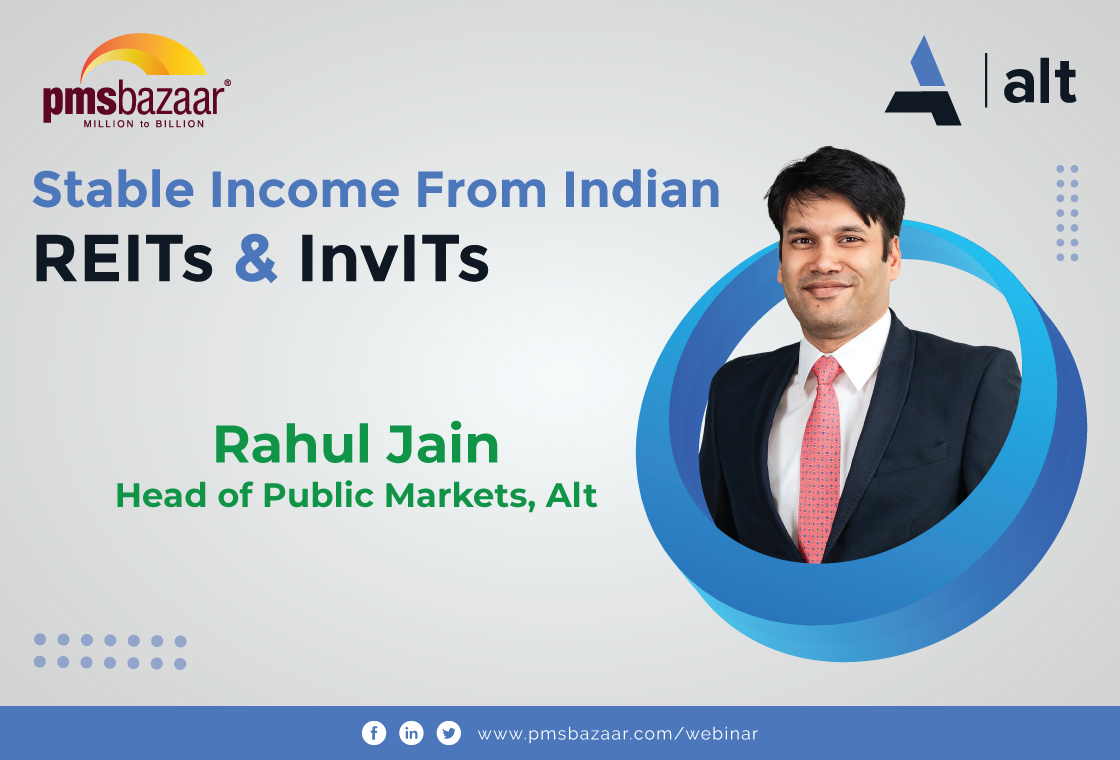Every major stock market has suffered net losses over the last year, but the Indian market has suffered less than most others. The S&P 500 index—the broad gauge of the US stock markets— is down 17 percent. Frankfurt’s DAX index is down 21 percent. The Shanghai Composite is down 15 percent. But the Nifty is down only 4 percent and even its US dollar-denominated twin, the Defty, is down only 12 percent despite the depreciation in the rupee during this period. Is there a clear explanation for the relative outperformance of Indian equities? This blog shall cover how the Indian equity market has outperformed global markets and in which areas.

Looking a little deeper, this strength of Indian market equities appears to be based on the optimism of domestic institutional investors. While the foreign portfolio investors have sold Rs 1.85 trillion worth of equity over the last 12 months, and retail investors have been net sellers in direct equity, domestic institutions, including mutual funds, have bought a net Rs 3.1 trillion, which has been enough to almost balance the selling pressure.
Based on this backdrop, PMS Bazaar conducted a webinar titled “Exclusive Outlook on India’s Outperformance and its Sustainability”. The keynote speaker was Mr. Naveen Kulkarni, CIO of Axis Securities Ltd. He spoke in-depth about the equity market performance and how sustainable is Indian equity market is likely to perform in the long run.
The following are some of the key points of the webinar
- Strong fundamental grounds
- NIFTY, PSU, Sector, Growth, and Value Stock Performance
- Market Capitalization, Valuations, and Commodities Performance
- Company Earnings, FIIs, and Macro Indicators
- India’s Nifty Index vs. VIX
1. Strong fundamental grounds
In the most recent couple of months, the Indian market performance demonstrated excellent resilience and exceeded the largest worldwide market by a promising margin. Mid- and small-cap stocks rebounded by 20% and 18%, respectively, while the benchmark index NIFTY 50 recovered by 15% from its low point. Stock market volatility is gauged by the volatility index (VIX), which is based on the implied volatility of S&P 500 Index options. When the VIX is low, volatility is low. When the VIX is high volatility is high, which is usually accompanied by market fear. The VIX currently stands lower than LTA and a clear trend is likely to emerge only when the volatility stays at lower levels for a longer period. The growth theme has performed all other styles by a notable margin in the last 6 months from the oversold zone. However, momentum as a theme gathered strength in the one month from the oversold zone.
After nine months since October 2021, FIIs started to turn net purchasers in July 2022, a trend that continued in August and September of that same year. In September and October 2022, there was a mixed trend; FIIs were net buyers in the first part of the month but switched to being net sellers by the month's conclusion after the hawkish Federal Open Market Committee (FMOC) meeting. FIIs withdrew $27 Bn that they had pumped in FY 21. However, the rate of selling has slowed down in the past three months, and since July 2022, FIIs have become net buyers. The dynamics of the market have altered in favor of domestically focused themes, which have outperformed them over the past two months, while export-focused themes will continue to trail behind. Before it concludes in a more specific direction, volatility is likely to linger for a little longer. The market is now focusing on holiday demand and Q2FY23 commentary. Due to weaker global cues and the Indian market's 93% connection with US markets over the past year, the market performance is anticipated to be range-bound in the short term.
The company's Q2FY23 revenues and earnings met forecasts. With most commodity prices, especially crude, cooling off, margins are anticipated to consolidate and possibly adopt a route toward moderation. The Q2FY23 inventory, however, has a higher RM cost. H2FY23 is anticipated to perform better in this situation than H1FY23. Better operational profit for the BFSI industry is projected to result from double-digit loan growth of 15% in August 2022. Management opinions would be a crucial indicator of the important infrastructure projects' progress and the demand for the upcoming festival.
2. NIFTY, PSU, Sector, Growth, and Value Stock Performance
The benchmark NIFTY 50 index has decreased by just 1.8% from the previous Diwali, whereas the S&P 500 and the emerging market index have decreased by a staggering 20% and 29%, respectively. The country's strong economic outlook is the driving force behind the outperformance. FMCG, Auto, Banks, and Energy indexes closed on positive notes since last Diwali, while Real Estate, IT, and Pharma concluded on negative notes. Since February 24, domestic and consumption-related cyclical themes have outperformed the market. On October 21, NIFTY reached an all-time high of 18477, and since then it has decreased by 5%. The utility industry has experienced a remarkable comeback from February 24, to 22. It has since increased by 35%. Since February 24, 2022, the IT industry has decreased by 12% as a result of expectations that the developed market will slow down. Banks, autos, and discretionary are among the industries that have improved over the past three to four months. Stocks ranking from 201-500 and 101-200 have beaten the Top 50 stocks in the most recent year, demonstrating the broader market's resiliency. The broader market is still the undisputed winner.
PSU banks have outperformed the private banks since June 17, 2022, thanks to stronger asset quality and double-digit growth, and PSU stocks have outperformed other themes on a YTD basis. PSU banks experienced a sharp comeback in the previous week as a result of better-than-anticipated quarterly earnings. In the current calendar year, the majority of public sector banks have outperformed the benchmark equity indices due to an improvement in asset quality and double-digit growth in their deposit and loan books. The Nifty PSU Bank index increased by 28 percent on a year-to-date basis through September 15 according to data available with Ace Equity, while the NSE Nifty increased by 3 percent over the same time. Since the market's bottom, 30 stocks—up from 9 on June 30th, 22—are trading at all-time highs. 35 percent of the 176 equities are trading between 5% and 20% below their 52-week highs. Nearly 58% of equities are currently trading at a discount to their 52-week high of 20%. At these prices, the market as a whole appears appealing. 5 PSU companies, including Coal India, SBI, BoB, Indian Bank, and Container Corp., are currently trading close to their 52-week high. After a choppy February and March, the market recovered in April but fell again in May and June due to a weaker global economy and worries about inflation. The market entered the oversold territory on June 22 when we hit levels of 18% of stocks trading above the 200-day moving average (DMA), which is roughly equal to the historical low.
Since then, the market has experienced a rapid recovery, and 50% of the stocks are currently trading above the 200-day moving average, indicating that the market is no longer oversold. However, the macroeconomic data will continue to dominate the market in the short term, and performance is expected to be range-bound for at least a quarter until signals of inflation moderation become apparent. India has outpaced the US and other significant Emerging markets during the past year. Up until October 21, it was more resilient and saw its indexes reach greater levels. NIFTY, however, has fallen 8% from its peak (Since October 18, 21), and Mid and Small Caps have also fallen 7%–8% from their peaks. Mar'22 turned out to be a comeback month following a significant sell-off on February 24th. The battered industries, such as auto, and FMCG, began to recover on April 22. However, due to weaker global cues and continuous FII selling in May'22, all sectors—aside from auto and FMCG—went into deep negative territory. The automobile was the only industry to end June 22 in the black. This resulted from a favorable forecast for domestic demand. All areas of recovery were seen on July 22. From the current levels, domestic-focused themes appear more appealing than export-focused themes. All industries in August 2018 are in the black, except pharmaceutical and information technology. Pharma increased by 2%, FMCG increased by 1%, and all other industries ended the month of September in the red. In the last one, three, or six months starting from the oversold zone, the growth theme significantly outperformed all other approaches. But over the past three months, the momentum theme has become stronger from the oversold region.
Growth stocks were the ones that were most affected by the recent correction, but during the past three months, they have rebounded quickly thanks to a decrease in commodity prices, strong domestic demand, and reasonable valuations following the correction. The momentum and growth themes have dominated the market for lengthier periods (1 and 2 years). Due to the domestic play of a typical monsoon, the drop in commodity prices, and the anticipation of strong consumption demand during the next festival season, the growth theme appears to be appealing. Given their recent decline, the chosen value stocks from the metals, commodities, utilities, and cement sectors are well-positioned to produce outstanding performance. Despite underperforming other themes over the past few months, value stocks in the BFSI sector are predicted to thrive going forward. Furthermore, despite the current difficult market, a structural growth play that offers long-term profit clarity will continue to do strongly.
3. Market Capitalization, Valuations, and Commodities Performance
Mcap of the Top 500 firms was Rs 231 Tn on September 22, a 3% MoM decrease. The levels of Sep'21 now apply to the full Mcap. Pharma and Staples experienced the most recovery on a MOM basis. Utilities are up 61% YoY, Industrials are up 16%, and Telecom is up 11%, but IT and pharmaceuticals are down 22% and 16%, respectively, YoY. The BFSI is appealing, particularly following the most recent correction (which was primarily driven by the FII selling). In terms of market capitalization, banks have surpassed the IT sector. Banks made up 1.4 times the IT market cap in the pre-Covid era. The market turnover increased to Rs. 48,000 Cr. in August after decreasing in Jun'22 as a result of volatility and poorer investor attitude, and it continued in Sep'22 with a turnover of Rs. 53,000 Cr. On June 22, there was a preference for large caps in the market turnover. Since then, it has been moving toward a larger market, demonstrating the market's resiliency. After the most recent drop, our Market Valuation Index has returned to the first decimal place. Long-term investors have a strong starting point at the current valuations.
To outperform at current levels, stock selection and sector switching would be essential. The India Valuation Index is developed using four key market indicators (12m fwd PE, 12m fwd PB, Bond Equity Earnings Yield Ratio, and Mcap to GDP Ratio). NIFTY is currently trading at 18.4x on a 12M forward PE, at first deviation from its long-term average, and below 1stdev on a 12M forward price band. The risk-reward ratio has dramatically improved over the previous three months, and the profits estimate for FY23 is still in place, therefore the present valuation (which is comparable to the 5-year average) appears to be favorable. The long-term bond yields have increased by 60 bps over the past six months when the RBI's anticipated rate hike is taken into account. The BEER ratio saw some cooling off following the last recent correction. However, it is currently trading over its LTA, suggesting that the equity market is currently significantly costlier than the bond market. (Rebased on FY22 GDP of Rs 232 Tn announced by the government on 1st Feb'22) India's Total Market Cap to GDP is trading at 108%, above its long-term average. However, the Mcap/GDP ratio converted to 103% at the nominal GDP levels expected for FY23 (fairly valued). The estimated GDP for FY23 is Rs 258 trillion. The market cap to GDP ratio reached 95–98% in FY10 results, which were experiencing a similar higher earnings momentum following the GFC crisis. The Mcap to GDP ratio is projected to increase in the next quarters due to the present cycle's favorable earnings trend. NIFTY is currently trading below the 1stdev on a 12M Fwd PB and at 19.6x on a 12M forward PE, which is the first to its long-term average. The risk-reward ratio has dramatically improved over the previous three months, and the profits estimate for FY23 is still in place, therefore the present valuation (which is comparable to the 5-year average) appears to be favorable.
FTSE India is trading at 2stdev rel. to FTSE Em index on 12m fwd PE. Currently, FTSE India is trading at a 91% premium to the EM Index as against a 39% average premium. Divergence is likely to continue on account of a) Robust economic growth vs. other EM countries, b) Strong earnings outlook, c) Robust demand across the sector, d) the Banking sector in better shape and e) Private Capex cycle expectation. Gold prices corrected by 8% in the last 3 months on account of rising interest rates and recovery in the equity markets. Over the last three months, steel prices have declined by 14%. Aluminum also witnessed significant moderation after touching an all-time high level in Mar’22 and is down 9% in 3 months. Brent crude is now trading around $88/bbl. It stood highly volatile in recent times due to the rising geopolitical risk. It's been over Seven months since the Russia-Ukraine conflict ensued, which has kept oil prices at an elevated level and has created upward inflation pressure.
4. Company Earnings, FIIs, and Macro Indicators
At current levels, PSU Banks, Energy, and the Metal Index are exhibiting valuation comfort. On the other hand, valuations for the IT, Pharma, and Auto sectors appear expensive. However, the valuation of the IT sector is likely to persist on account of a strong structural theme emerging in the sector. We foresee FY23/24 NIFTY Earnings at 820/929. After Q1FY23, we change our FY23/24 expectations marginally by -0.7%/1% and stand conservative at 4%/7% below the street expectations. Financials are the biggest contributor to the FY23 earnings. We roll over our NIFTY target to Mar’23 to 18,400 by valuing it at 20x FY24 earnings vs. 22x earlier. We cut our NIFTY multiple to accommodate the rising interest rate scenario, which started with a 40bps rate hike in the unscheduled MPC meet in early May’22. We believe aggressive policy tightening would curb inflation. However, the persistently elevated Oil and Commodity prices would pose challenges to the market multiple over the next few quarters.
The last 4 quarters’ cumulative net profit has reached an all-time high, crossing Rs 10 Lc Cr in Q1FY23. The Financials are now significantly contributing to the Net Profit as against their contribution in 2019. Financials, Oil &Gas, Metals, and IT are now contributing 68% of the NSE 500 profitability. Loss-making sectors have turned positive post witnessing significant disruption by the pandemic. ROE is improving across the market caps. Smaller stocks, too, have been showcasing a significant improvement. ROE of cyclical sectors has improved in the last 1-2 years. Moreover, current ratios are higher than pre-pandemic levels. Significant improvement has been seen in the PSU banks in the last 3 years. The profitability of the Automobile and Infra sectors has improved in the last couple of years led by a positive outlook. After 9 months since Oct’21, FIIs turned net buyers for the first time in Jul’22 which continued in Aug/Sep’22 as well. The mixed trend was visible in Sep’22, in which FIIs were the net buyer in the first half but turned into net sellers during the end of the month post the hawkish FOMC meeting. FIIs have pulled out the majority of the easy money from the Indian market which they pumped in after the Covid-19 crisis in Mar’20.
They took $26 billion in FY22/23 out of the $37 billion they poured in FY21. Despite this, sales have slowed down during the past three months. Since July 22, they have changed from sellers to buyers. Since July 22, FII selling has slowed down in all emerging markets. Before now, FIIs withdrew capital from the emerging market due to escalating expectations of rate hikes. India would be a desirable location for FIIs after the dust settles, even though the outlook is uncertain in the immediate future. This is due to India's predictable political landscape, solid GDP growth, optimistic forecast for profit growth, and manageable budget deficit.
GDP for Jun’22 quarter grew 13.5% (slightly below the consensus estimates). Base effects make it hard to read Jun’22 quarter GDP – in YoY terms. However, momentum in net exports and investment on the demand side marginally slowed down. On the supply side, there is moderation in manufacturing and all service segments, except for public administration and personal services. The outlook for growth in India is good since policy intervention has ensured an adequate supply of inputs and lowered input costs. Healthy pick-up in the economic activities continued in Sep’22. Electricity generation in Sep’22 posted an encouraging growth indicating significant improvement in economic activities. Healthy momentum was also seen in the E-way bills with 7.8 Cr bills generated in Aug’22, higher than the pre-pandemic average. Jul’22 CPI rose by 7%, slightly above the street expectations driven by higher food prices. Sequential moderation was seen on account of some cool-off in food and vegetable prices. Since the CPI has not yet completely reflected the effects of excise tax reductions and export duties on key commodities, more moderation is likely to occur in the coming months. Fundamentally, the earnings trajectory for the Indian market has begun to ascend. The rise in three macro variables, namely the US bond yields, the Dollar Index, and the likelihood of aggressive rate hikes, has, nevertheless, impacted the short-term behavior of FII (in terms of stock flow in the developing market). Following the September 22 FOMC meeting, US bond rates increased by 4% on expectations that rate hikes will continue until inflation is within a comfortable range. The Dollar Index has advanced to the level of 114, creating a weakness in the domestic market. The correlation between the Indian market and the US market remains high at 93%.
5. India’s Nifty Index vs. VIX
The Indian market performance showed resilience in the last couple of months and outperformed the major global market by a superior margin. Our benchmark index NIFTY 50 recovered by 12% from the bottom (since 17th Jun’22), and both Mid and Small Cap indices recovered by 19%/16% over the same period. However, the NIFTY is still trading below 6% from the top (since 18th Oct 21) and both Mid and Small Cap indices are 6%/7% below the 18th Oct levels. Recovery continued in Sep'22 during which the market touched a level of 18,000 on account of a robust economic outlook compared to other emerging markets.
In anticipation of a strong domestic recovery and growing confidence in the "India narrative," FIIs changed from net sellers to net purchasers in the domestic market during the first half of the month. However, after the hawkish FOMC meeting last week, there was some selling pressure. The dynamics of the market have altered in favor of domestically focused themes, which have outperformed them over the past two months, while export-focused themes will continue to trail behind. Before it concludes in a more specific direction, volatility is likely to linger for a little longer. The market is now focusing on holiday demand and Q2FY23 commentary. Due to weaker global cues and the Indian market's 93% annual correlation with US markets, the market performance is anticipated to be range-bound in the short term.
Mr. Kulkarni discussed all the above topics in detail. Towards the end, Mr. Amit answered questions from the audience. For more insights on this webinar, please click the appended link.
Get access to rich data and analytics of PMS & AIF by subscribing to us. Join the 40000+ investors & experts now: Subscribe NOW
Recent Blogs
.jpg)
Passively Active Investing — A Modern Investor’s Lens on ETF-Based PMS
PMS Bazaar recently organized a webinar titled “Passively Active Investing — A Modern Investor’s Lens on ETF-Based PMS,” which featured Mr. Karan Bhatia, Co-Founder and Co-Fund Manager , Pricebridge Honeycomb ETF PMs. This blog covers the important points shared in this insightful webinar.

Spot the Trouble: Red Flags in Equity Investment Analysis
PMS Bazaar recently organized a webinar titled “Spot the Trouble: Red Flags in Equity Investment Analysis,” which featured Mr. Arpit Shah, Co-Founder & Director, Care Portfolio Managers. This blog covers the important points shared in this insightful webinar.

Long-Only AIFs Rebound Sharply in October; Long-Short Strategies Lag Despite Lower Volatility
106 long-only AIFs averaged 3.68% vs 32 long-short AIFs at 2.7%; only 24–31% of funds beat key indices

Markets log strongest monthly gains in 7 months; PMS performance turns near-uniform in October
Nifty 50 TRI gained 4.62%, BSE 500 TRI rose 4.27%; 415 of 427 equity PMSes ended positive

How SMEs are Shaping India’s Investment Landscape?
PMS Bazaar recently organized a webinar titled “How SMEs are Shaping India’s Investment Landscape?” which featured Mr. Shrikant Goyal, Fund Manager, GetFive Opportunity Fund.

Stable Income from Indian REITs and InvITs
PMS Bazaar recently organized a webinar titled “Stable Income from Indian REITs and InvITs,” which featured Mr. Rahul Jain, Head of Public Markets, Alt.

5 Key Considerations Before Investing in AIFs in India
Alternative Investment Funds (AIFs) have emerged as a compelling option for sophisticated investors seeking diversification and potentially superior returns. But venturing into AIFs requires a clear understanding of their unique characteristics that go beyond simply knowing what they are and their categories.

How AIF can help in diversification?
Traditionally, Indian investors have relied on a mix of stocks and bonds to build their wealth. While this approach offers diversification, it can still leave your portfolio vulnerable to market fluctuations. Enter Alternative Investment Funds (AIFs), a dynamic asset class gaining traction for its ability to unlock diversification beyond the realm of conventional options.

